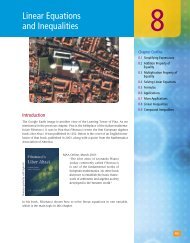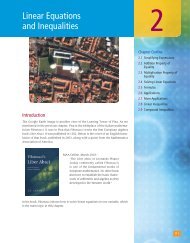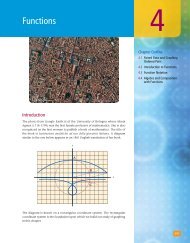Polynomials: Factoring - XYZ Custom Plus
Polynomials: Factoring - XYZ Custom Plus
Polynomials: Factoring - XYZ Custom Plus
Create successful ePaper yourself
Turn your PDF publications into a flip-book with our unique Google optimized e-Paper software.
Applications 12.8In this section we will look at some application problems, the solutions to whichrequire solving a quadratic equation. We will also introduce the Pythagoreantheorem, one of the oldest theorems in the history of mathematics. The personwhose name we associate with the theorem, Pythagoras (of Samos), was a Greekphilosopher and mathematician who lived from about 560 b.c. to 480 b.c. Accordingto the British philosopher Bertrand Russell, Pythagoras was “intellectually oneof the most important men that ever lived.”Also in this section, the solutions to the examples show only the essentialsteps from our Blueprint for Problem Solving. Recall that step 1 is done mentally;we read the problem and mentally list the items that are known and the itemsthat are unknown. This is an essential part of problem solving. However, nowthat you have had experience with application problems, you are doing step 1automatically.ObjectivesA Solve number problems by factoring.B Solve geometry problems byfactoring.C Use the Pythagorean Theorem tosolve problems.Examples now playing atMathTV.com/booksANumber ProblemsExample 1The product of two consecutive odd integers is 63. Findthe integers.Solution Let x = the first odd integer; then x + 2 = the second odd integer. Anequation that describes the situation is:1. The product of two consecutiveeven integers is 48. Find theintegers. (Hint: If x is one of theeven integers, then x + 2 is thenext consecutive even integer.)Practice Problemsx (x + 2) = 63 Their product is 63We solve the equation:x (x + 2) = 63x 2 + 2x = 63x 2 + 2x − 63 = 0(x − 7)(x + 9) = 0x − 7 = 0 or x + 9 = 0x = 7 or x = −9If the first odd integer is 7, the next odd integer is 7 + 2 = 9. If the first odd integeris −9, the next consecutive odd integer is −9 + 2 = −7. We have two pairs ofconsecutive odd integers that are solutions. They are 7, 9 and −9, −7.We check to see that their products are 63:7(9) = 63−7(−9) = 63Suppose we know that the sum of two numbers is 50. We want to find a way torepresent each number using only one variable. If we let x represent one of thetwo numbers, how can we represent the other? Let’s suppose for a moment thatx turns out to be 30. Then the other number will be 20, because their sum is 50;that is, if two numbers add up to 50 and one of them is 30, then the other must be50 − 30 = 20. Generalizing this to any number x, we see that if two numbers haveAnswer1. −8, −6 and 6, 812.8 Applications785
















